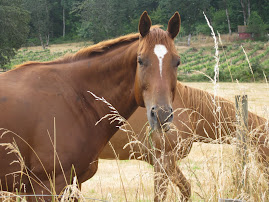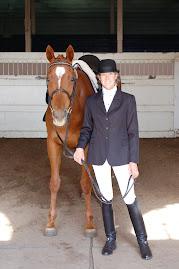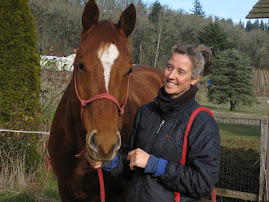Read Dr. Gerd Heuschmann's book about Classic vs. "Modern" Dressage and you will read about Leg and Back Movers.
Watch horses that are compressed into a frame and you will see a Leg Mover...
Watch horses allowed to stretch through their frame and you will see a Back Mover...
The labels imply exactly what happens when a horse is ridden in a "compressed" frame as opposed to a "through" frame.
COMPRESSION is created when a horse is ridden from front-to-back and the major focal point of WHERE the horse is ridden from is the rider's reins.
In a compression frame, the horse is ridden with short reins, the legs and seat are used to drive the horse forward, and "into" the bridle. This is what has become to be understood as "Collection"....However, when the reins are shortened and the horse is driven, the opposite happens...
As the legs push the horse forward, the seat tends to be heavy and pushes down on the horse's back, causing tension over the topline, driving the horse's back away from the rider's seat in a concave arch.
The reins are then short and restrictive through the overuse of the halfhalt, creating lack of movement throughout the neck and poll, therefore allowing the horse to drop his/her shoulders (incorrect).
This style of riding creates a horse who is locked in his/her poll, stiff in his/her neck, dropped in his/her back, locked in his/her ribcage, and! not using his/her hindend correctly, therefore heavy on the frontend.
It would SEEM that this would work to ride a horse this way...but what this style of riding creates is a sore and grumpy horse who lacks muscle tone in all the right places. Tense Back. Tense Horse. Only the legs move...
It creates a LEG MOVER.
THROUGH is created when a horse is ridden from back-to-front and the
major focal point of WHERE the horse is ridden from is the rider's body.
In a through frame, the horse is ridden from the body where the legs and seat allow the horse to find the bridle, therefore, be ridden "into" the bridle. "Collection" can also be achieved in this frame, but it takes time as the horse is slowly brought into a state of collection...
As the legs push the horse forward, the seat is soft and allows a "place" for the back. When the seat needs to "drive," it is in an upward, forward motion. The back follows this motion, creating flexion in the belly muscles and the topline.
The rein length can vary with a horse that is "through" depending on where the horse is in his/her training. The halfhalt is still incorporated, except it initiates from the body, before the hand. The "hand" halfhalt reinforces the "body" halfhalt. The reins are like "sticks" and pushed towards the front, giving the horse incentive to find the bit and, eventually, "into the bridle." Given the opportunity, the horse will lower his/her head into a "headset" without much work on your part.
The more green the horse, the longer the frame. The more schooled the horse, the shorter the frame.
HOWEVER, A SCHOOLED HORSE THAT IS THROUGH WILL BE ABLE TO FIND THE LONG AND LOW FRAME NO MATTER WHEN IT IS ASKED.
When a horse is ridden over its topline and allowed to raise the back, the neck naturally balances by stretching down, creating a horse with SPACE. Space creates fluidity in movement.
Space in the connections between the poll and neck.
Space in the connections between the shoulders and ribcage.
Space in the belly and back.
Space in the hindquarters.
When a horse can swing his/her back you have relaxation.
Relaxed Back. Relaxed Horse. The whole body moves...
It creates a Back Mover.
Wednesday, February 8, 2012
Subscribe to:
Post Comments (Atom)



No comments:
Post a Comment